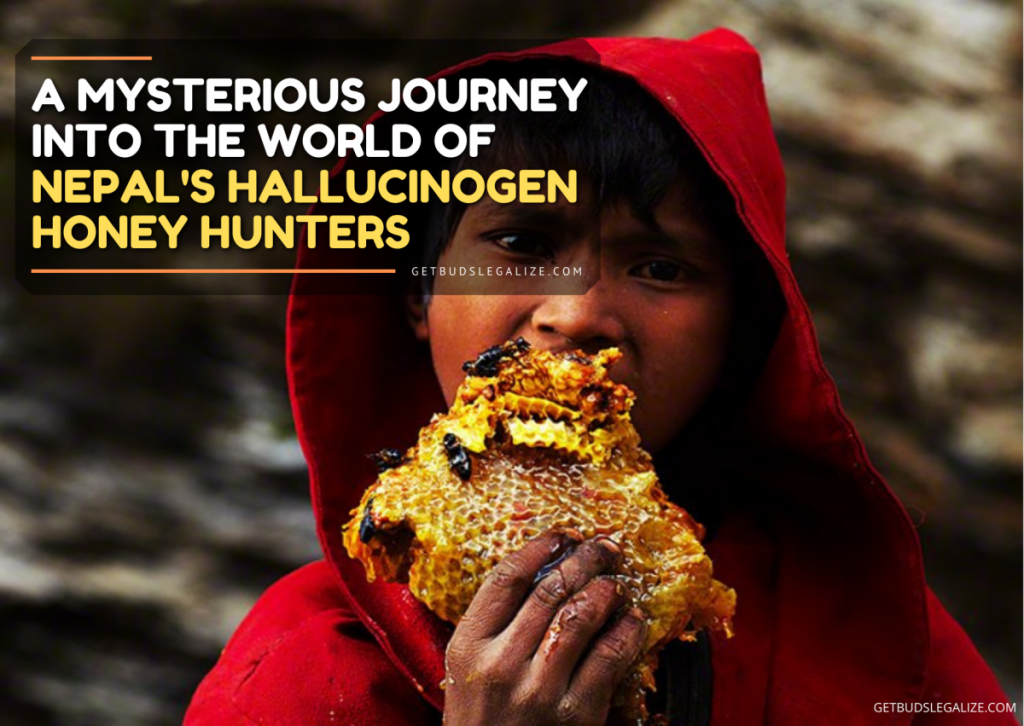The Hallucinogen Honey Hunters of the Himalayas: A Daring Tradition Steeped in Mystery
Discover the Mesmerizing World of the Himalayan Honey Hunters
Deep in the towering cliffs of the Himalayas, the Gurung tribe of Nepal carries on an extraordinary and dangerous tradition—the harvest of hallucinogenic honey, also known as mad honey. This ancient practice is a testament to human resilience, bravery, and the intricate connection between nature and spirituality.
In this adventure, honey hunters scale cliffs hundreds of feet high, defying death to collect a unique honey that holds both medicinal and hallucinogenic properties. Let’s explore this incredible ritual, its cultural significance, and why the art of honey hunting may soon be lost forever.
What is Hallucinogenic Honey?
Mad honey is a rare type of honey that contains grayanotoxins, natural neurotoxins found in the nectar of the rhododendron flowers in Nepal. These toxins give mad honey its hallucinogenic properties, causing symptoms like lightheadedness, euphoria, and hallucinations when consumed in moderate amounts. Overconsumption, however, can lead to more severe reactions.
The Daring Lives of Nepal's Honey Hunters: Guardians of a Sacred Tradition
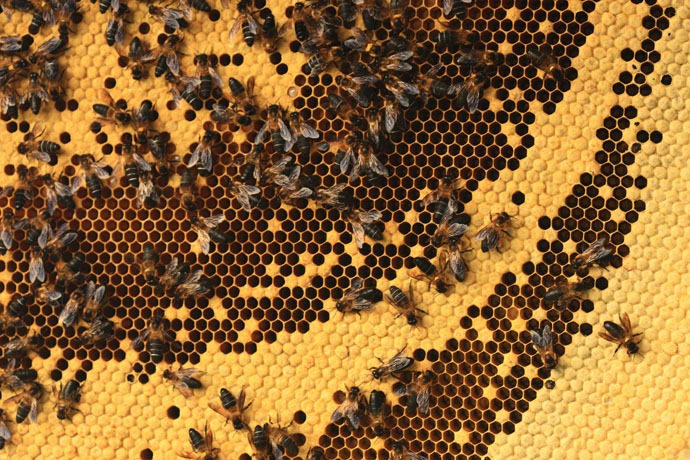
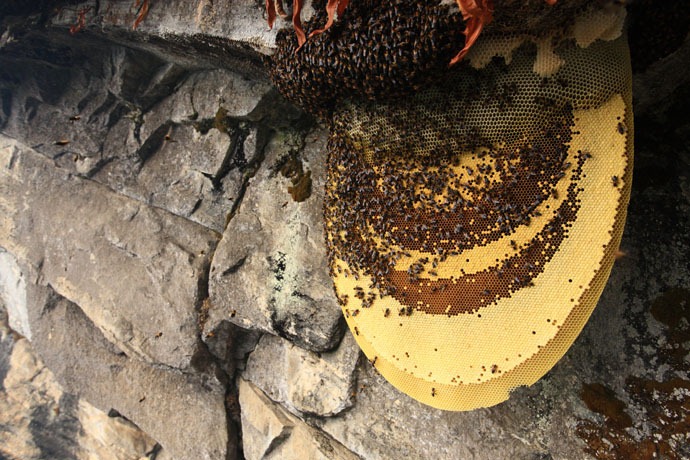
The Gurung Tribe: Keepers of an Ancient Craft
For centuries, the Gurung people have been the custodians of honey hunting in the central Himalayas of Nepal. This isn’t just a practice; it’s a cultural and spiritual event steeped in rituals and ceremonies. The honey they collect isn’t just a product of their labor; it’s a symbol of their relationship with the land, the bees, and their ancestors.
Why the Honey Hunt Matters to the Gurung People
For the Gurung tribe, honey hunting represents more than survival. It’s an integral part of their identity, where rituals and prayers are offered before every hunt to appease the mountain gods and ensure safety. This profound connection to nature is celebrated twice a year during honey-harvesting festivals.
The High-Risk Journey: How Honey Hunting Is Done
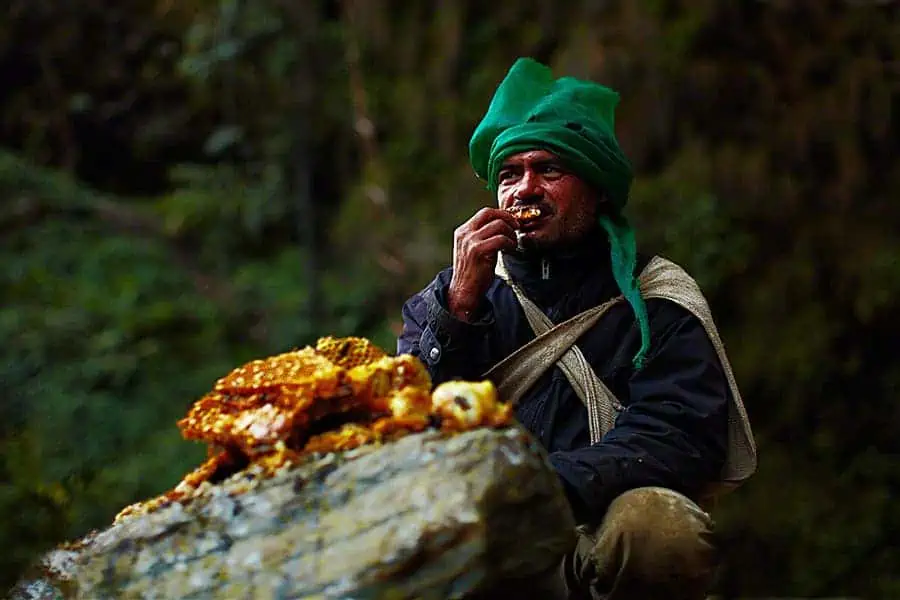
Step 1: Preparing for the Climb
Before the hunters ascend, they undergo a sacred purification ritual, including prayers and offerings to the gods believed to protect them during their perilous mission. This preparation is essential, as it ensures the favor of the spirits and sets the tone for the difficult journey ahead.
Step 2: Scaling the Cliffs
Once the prayers are complete, the real danger begins. The honey hunters climb cliffs, often exceeding 300 feet in height, using only hand-made bamboo ladders and ropes. Equipped with just the essentials—smoke to calm the bees, a basket to collect honeycombs, and a sharp tool called a tango—they face swarming bees and extreme heights.
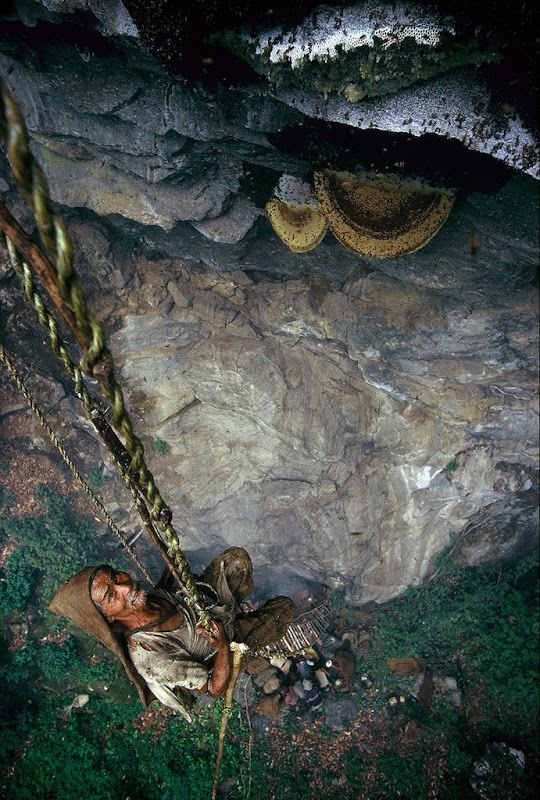
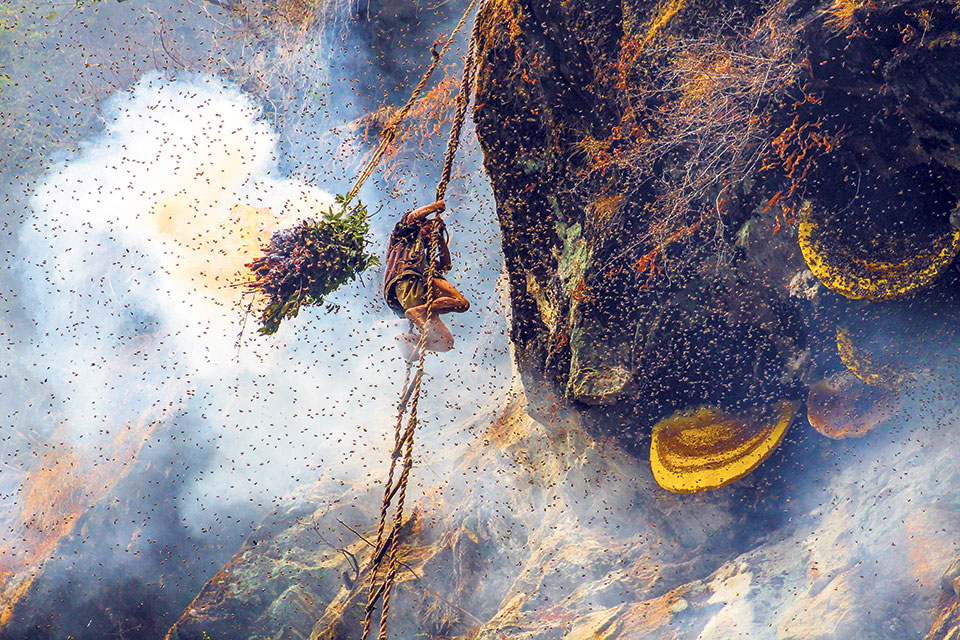
Step 3: Harvesting the Honey
The bees, Apis laboriosa, the largest in the world, are known for their aggression when disturbed. The hunters must use smoke to sedate them long enough to gather the honey. With their hands exposed to hundreds of stings, they delicately cut the honeycomb and collect the honey in baskets, descending cautiously as they gather their prized nectar.
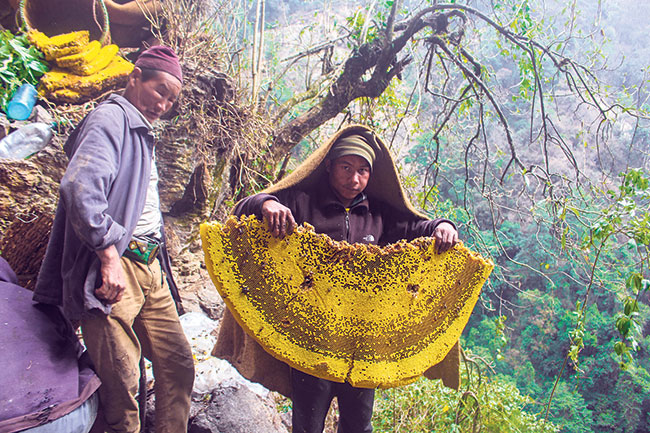
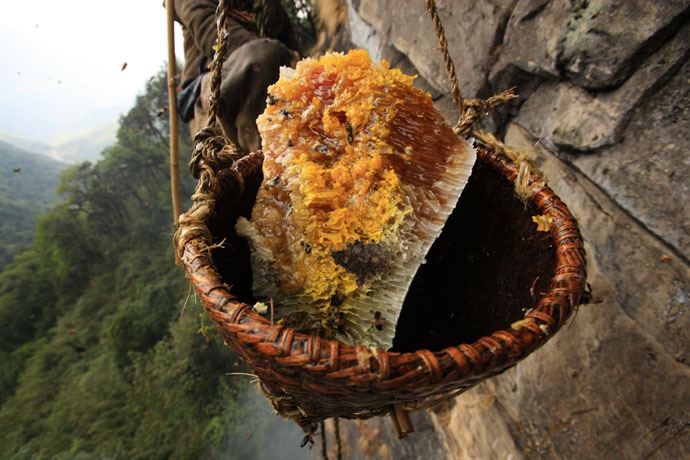
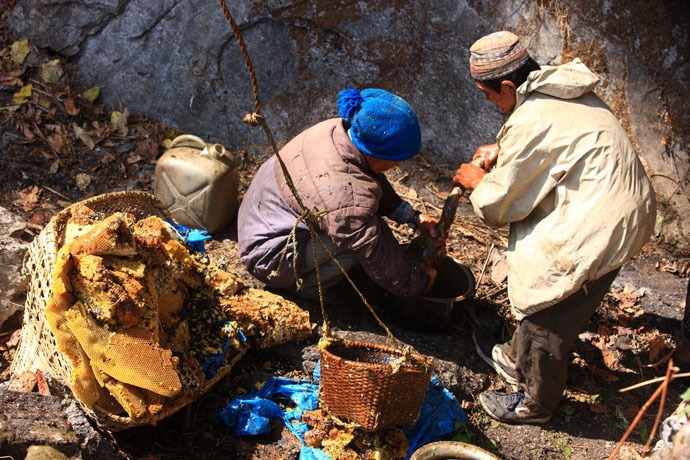
Hallucinogenic Honey: More Than Just a Sweet Treat
The Psychoactive Powers of Mad Honey
The honey harvested by the Gurung tribe has gained global attention for its hallucinogenic effects. Thanks to the grayanotoxins present in rhododendron nectar, this honey produces a range of experiences when consumed. From mild euphoria to full-blown hallucinations, this is no ordinary honey.
Why People Risk It All for Mad Honey
Beyond its psychoactive effects, mad honey is also valued for its medicinal properties. It’s used traditionally to:
- Lower blood pressure
- Improving sexual stamina
- Relieving joint pain
- Boosting energy
However, it’s important to note that too much mad honey can lead to severe side effects, such as nausea, dizziness, and confusion.
Threats to an Ancient Tradition: Can Honey Hunting Survive Modern Times?
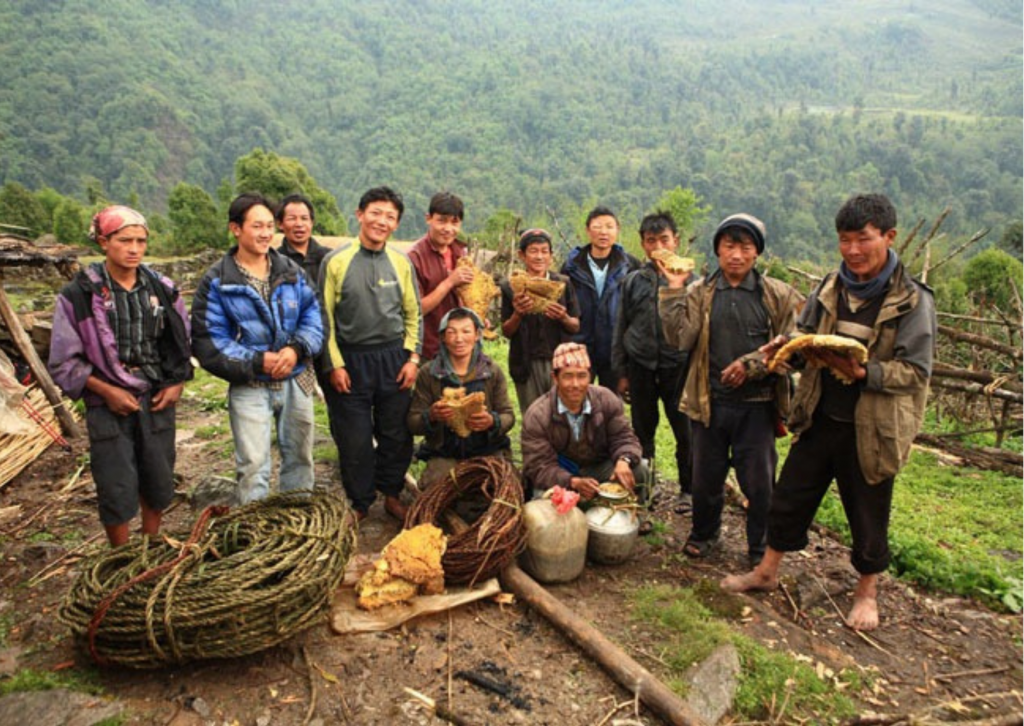
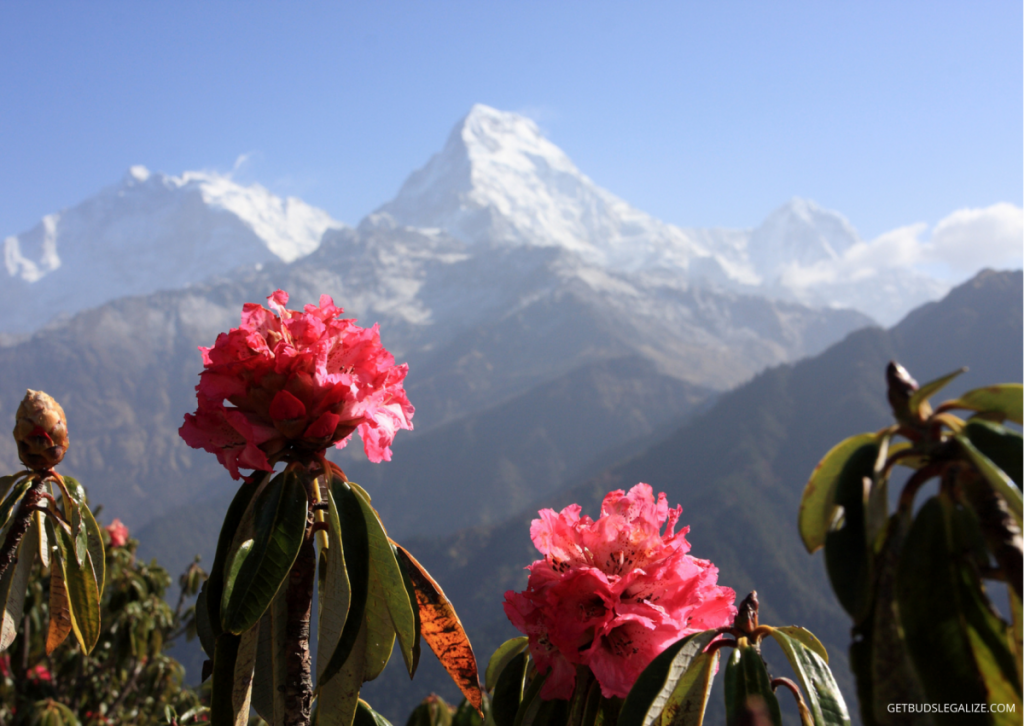
The Decline of Honey Hunting in Nepal
The ancient art of honey hunting is on the brink of extinction. Modernization, deforestation, and commercialization are rapidly eroding this centuries-old tradition. As younger generations gravitate toward urban life and tourism, fewer people are willing to undertake the dangerous practice of honey hunting.
The Impact of Commercial Exploitation
Increased global demand for hallucinogenic honey has put added pressure on the environment. Overharvesting is threatening the delicate balance between the bees, the rhododendron flowers, and the ecosystem. Furthermore, as more tourists flock to witness the honey hunts, there’s a growing concern that this sacred practice is being commodified.
Can Sustainable Tourism Save Honey Hunting?
Tourism offers a dual-edged sword for the Gurung people. While it generates essential income that helps sustain their cultural heritage, it also brings risks of over-commercialization and environmental degradation. Embracing sustainable tourism practices could strike a balance, allowing the rich tradition of honey hunting to thrive while safeguarding the bees and their natural habitats.
The Health Risks of Mad Honey: How Much Is Too Much?

The Side Effects of Hallucinogenic Honey
While mad honey can offer numerous benefits, it comes with risks. Consuming too much can lead to:
- Dizziness
- Low blood pressure
- Nausea
- Hallucinations
- In severe cases, mad honey poisoning, which requires medical attention.
It’s important for those trying mad honey to do so cautiously and understand the potential side effects. It’s not a substance to be taken lightly.
Correlated article:
Preserving the Legacy of Nepal's Hallucinogenic Honey Hunters
The Future of Honey Hunting
The future of honey hunting lies in the balance between tradition and modernization. Conservation efforts are underway to preserve both the ecosystem that supports the bees and the cultural heritage of the Gurung people. Protecting this unique practice requires careful management of resources, ethical tourism, and the passing of knowledge to future generations.
How You Can Support Ethical Honey Hunting
Tourists can play a pivotal role in ensuring the sustainability of honey hunting. By supporting eco-friendly tours and purchasing ethically sourced honey, you contribute to the conservation of bees and the survival of an ancient way of life. Responsible tourism ensures that both the environment and the Gurung culture are preserved for future generations.
Conclusion: A Tradition Hanging by a Thread
The world of the Himalayan Hallucinogen Honey Hunters is as dangerous as it is fascinating. This ancient tradition, with its mix of mysticism, risk, and reward, offers a rare glimpse into a culture that defies modernity.
Yet, as the world changes, so does the delicate balance of this tradition. With conservation efforts and sustainable tourism, we can help protect this endangered practice, ensuring that the Gurung people continue to carry on their legacy for generations to come.
IMAGE SOURCE: Andrew Newey, Éric Tournere, Eric Valli
Vice Mad Honey Documentary
FAQs about Hallucinogen Honey Hunters
The key reason people hallucinate after consuming Nepalese honey is the presence of grayanotoxins, which are found in the nectar of rhododendron flowers. This honey, produced by giant Himalayan bees, contains these toxins, which affect the nervous system and can induce symptoms like dizziness, nausea, and hallucinations when consumed in larger quantities. Known as hallucinogen honey, its effects vary from person to person, with some experiencing light-headedness and others describing vivid, dream-like visions.
The life of the Nepal honey hunters is filled with dangers. They scale cliffs that reach heights of up to 300 feet with minimal safety equipment to gather honey from the nests of aggressive giant Himalayan bees.
Additionally, the harsh weather conditions in the Himalayas add another layer of risk to the process. These hallucinogen honey hunters continue the ancient tradition despite the dangers, driven by cultural heritage and the value of the honey they harvest.
Yes, tourists can participate in honey hunting tours that allow them to witness the Nepal honey hunters in action. Visitors can watch the harvesting process and sometimes try a small amount of the hallucinogen honey themselves.
However, it’s important to consume it with caution, as the honey can cause intense side effects. Many local guides recommend starting with a small dose to gauge its potency.
The practice of honey hunting in Nepal faces modern-day challenges that threaten its existence. As younger generations move to cities in search of better job opportunities, fewer people are willing to become Nepalese honey hunters.
Additionally, climate change and over-harvesting have affected bee populations, making it harder to find sustainable honeycombs. Though efforts are underway to conserve the practice, the future of hallucinogen honeyhunters remains uncertain.
Yes, Nepalese honey has long been used for medicinal purposes in addition to its hallucinogenic properties. Locals believe it offers pain relief, boosts energy, and helps regulate blood pressure when consumed in small doses. It’s also thought to enhance sexual performance and stamina.
However, due to the presence of grayanotoxins, excessive consumption can cause adverse side effects, so it’s important to use it with caution.
Nepalese honey stands out from other honey varieties because it contains grayanotoxins from the nectar of rhododendron flowers, which gives it its hallucinogenic effects. This rare honey, harvested by Nepal honey hunters, has a distinctive reddish hue and a slightly bitter taste. The process of collecting this honey is dangerous, and its scarcity adds to its value, making it a prized cultural delicacy in Nepal.
The correct dosage of mad honey, also known as hallucinogen honey, varies depending on an individual’s tolerance. For beginners, it is recommended to start with half a teaspoon and wait for 30-60 minutes to assess the effects before consuming more.
The honey is potent, and excessive intake can cause adverse side effects like dizziness, nausea, and even loss of consciousness. Traditionally, locals consume very small amounts of this Nepalese honey for medicinal purposes. Anyone unfamiliar with it should approach it with caution and avoid overconsumption.
The legality of Himalayan mad honey varies by country. In Nepal, it is legal and often harvested for local consumption as well as for sale to tourists. However, in other countries, particularly in Western nations, the sale and importation of hallucinogen honey may be restricted due to its psychoactive properties.
It’s important to check local regulations before purchasing or importing Nepalese honey. Some countries may allow it as a novelty or food product, while others might classify it as a controlled substance due to its hallucinogenic effects.
When consumed in small amounts, Himalayan mad honey is generally safe and is even used by locals for medicinal purposes. However, due to its content of grayanotoxins, overconsumption can lead to severe symptoms such as nausea, vomiting, sweating, and heart problems.
Some people may experience more serious symptoms, such as fainting or even hallucinations. It’s important to consume it responsibly and only in small doses to avoid adverse side effects. Consult a local expert or guide before trying this honey for the first time.
You can search for “honey hunters of Nepal documentary” to find documentaries that explore the lives and traditions of these fascinating honey hunters.
Yes, you can look for “hallucinogen honey hunters Netflix” to discover content that covers this unique practice and the experiences of honey hunters.
ILGM Fertilizer

- From seedling to harvest, give your plants everything they need.
- Enough for feeding at least 5 plants.
- Discounted Package Deal
- Works well in soil, hydroponics, and other growing mediums.
- The best way to treat your plants
ILGM Plant Protector

- Protect your cannabis from diseases and harmful pests.
- Contains three 20 ml bottles.
- Enough supplies to protect 20 plants.
- It can be used in soil, hydroponic, and all other growing mediums.

